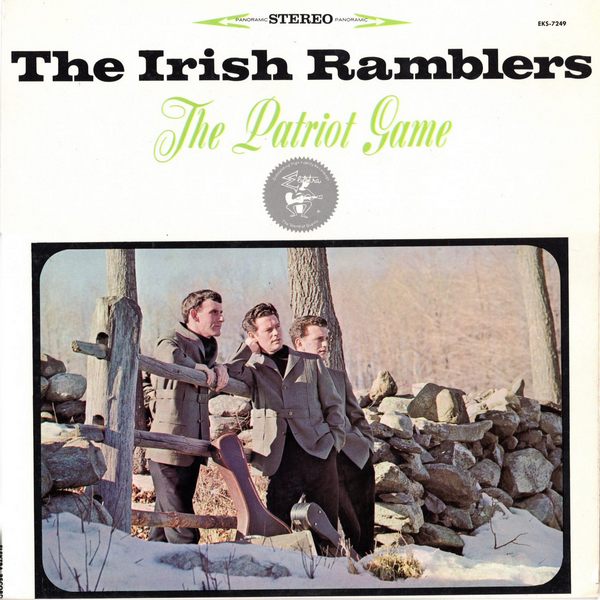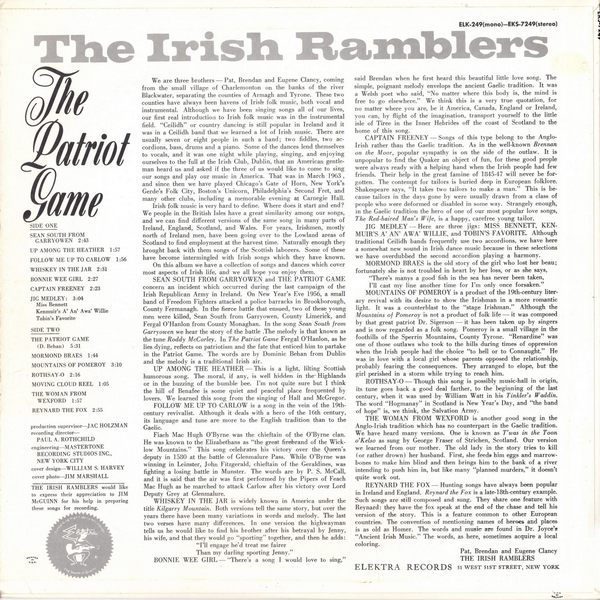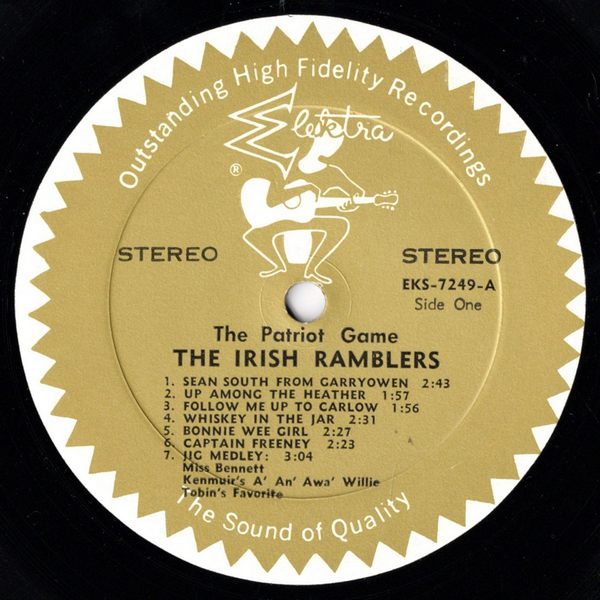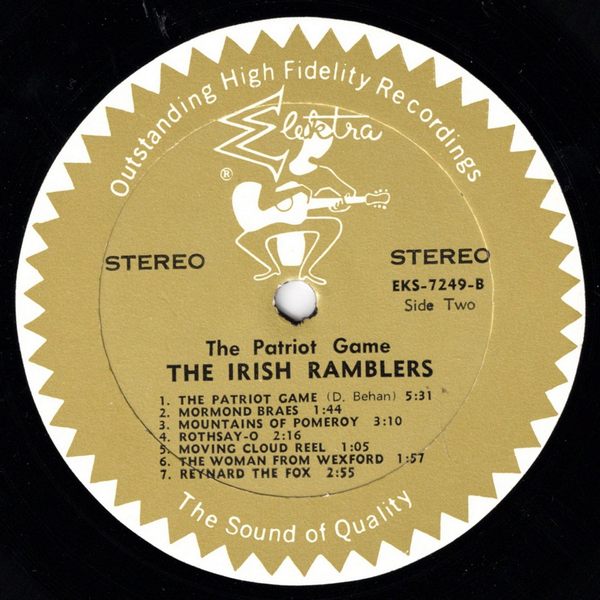
 |



|
Sleeve Notes
We are three brothers — Pat, Brendan and Eugene Clancy, coming from the small village of Charlemonton on the banks of the river Blackwater, separating the counties of Armagh and Tyrone. These two counties have always been havens of Irish folk music, both vocal and instrumental. Although we have been singing songs all of our lives, our first real introduction to Irish folk music was in the instrumental field. "Ceilidh" or country dancing is still popular in Ireland and it was in a Ceilidh band that we learned a lot of Irish music. There are usually seven or eight people in such a band; two fiddles, two accordions, bass, drums and a piano. Some of the dances lend themselves to vocals, and it was one night while playing, singing, and enjoying ourselves to the full at the Irish Club, Dublin, that an American gentleman heard us and asked if the three of us would like to come to sing our songs and play our music in America. That was in March 1963, and since then we have played Chicago's Gate of Horn, New York's Gerde's Folk City, Boston's Unicorn, Philadelphia's Second Fret, and many other clubs, including a memorable evening at Carnegie Hall.
Irish folk music is very hard to define. Where does it start and end? We people in the British Isles have a great similarity among our songs, and we can find different versions of the same song in many parts of Ireland, England, Scotland, and Wales. For years, Irishmen, mostly north of Ireland men, have been going over to the Lowland areas of Scotland to find employment at the harvest time. Naturally enough they brought back with them songs of the Scottish laborers. Some of these have become intermingled with Irish songs which they have known.
On this album we have a collection of songs and dances which cover most aspects of Irish life, and we all hope you enjoy them.
SEÁN SOUTH FROM GARRYOWEN and THE PATRIOT GAME concern an incident which occurred during the last campaign of the Irish Republican Army in Ireland. On New Year's Eve 1956, a small band of Freedom Fighters attacked a police barracks in Brookborough, County Fermanagh. In the fierce battle that ensued, two of these young men were killed, Seán South from Garryowen, County Limerick, and Fergal O'Hanlon from County Monaghan. In the song Seán South from Garryowen we hear the story of the battle. The melody is that known as the tune Roddy McCorley. In The Patriot Game Fergal O'Hanlon, as he lies dying, reflects on patriotism and the fate that enticed him to partake in the Patriot Game. The words are by Dominic Behan from Dublin and the melody is a traditional Irish air.
UP AMONG THE HEATHER — This is a light, lilting Scottish humorous song. The moral, if any, is well hidden in the Highlands or in the buzzing of the bumble bee. I'm not quite sure but I think the hill of Benafee is some quiet and peaceful place frequented by lovers. We learned this song from the singing of Hall and McGregor.
FOLLOW ME UP TO CARLOW is a song in the vein of the 19th-century revivalist. Although it deals with a hero of the 16th century, its language and tune are more to the English tradition than to the Gaelic.
Fiach Mac Hugh O'Byrne was the chieftain of the O'Byrne clan. He was known to the Elizabethans as "the great firebrand of the Wicklow Mountains." This song celebrates his victory over the Queen's deputy in 1580 at the battle of Glenmalure Pass. While O'Byrne was winning in Leinster, John Fitzgerald, chieftain of the Geraldines, was fighting a losing battle in Munster. The words are by P. S. McCall, and it is said that the air was first performed by the Pipers of Feach Mac Hugh as he marched to attack Carlow after his victory over Lord Deputy Grey at Glenmalure.
WHISKEY IN THE JAR is widely known in America under the title Kilgarry Mountain. Both versions tell the same story, but over the years there have been many variations in words and melody. The last two verses have many differences. In one version the highwayman tells us he would like to find his brother after his betrayal by Jenny, his wife, and that they would go "sporting" together, and then he adds:
"I'll engage he'd treat me fairer
Than my darling sporting Jenny."
BONNIE WEE GIRL — "There's a song I would love to sing," said Brendan when he first heard this beautiful little love song. The simple, poignant melody envelops the ancient Gaelic tradition. It was a Welsh poet who said, "No matter where this body is, the mind is free to go elsewhere." We think this is a very true quotation, for no matter where you are, be it America, Canada, England or Ireland, you can, by flight of the imagination, transport yourself to the little isle of Tiree in the Inner Hebrides off the coast of Scotland to the home of this song.
CAPTAIN FREENEY — Songs of this type belong to the Anglo-Irish rather than the Gaelic tradition. As in the well-known Brennan on the Moor, popular sympathy is on the side of the outlaw. It is unpopular to find the Quaker an object of fun, for these good people were always ready with a helping hand when the Irish people had few friends. Their help in the great famine of 1845-47 will never be forgotten. The contempt for tailors is buried deep in European folklore. Shakespeare says, "It takes two tailors to make a man." This is because tailors in the days gone by were usually drawn from a class of people who were deformed or disabled in some way. Strangely enough, in the Gaelic tradition the hero of one of our most popular love songs, The Red-haired Mans Wife, is a happy, carefree young tailor.
JIG MEDLEY — Here are three jigs: MISS BENNETT, KENMUIR'S A' AN' AWA' WILLIE, and TOBIN'S FAVORITE. Although traditional Ceilidh bands frequently use two accordions, we have here a somewhat new sound in Irish dance music because in these selections we have overdubbed the second accordion playing a harmony.
MORMOND BRAES is the old story of the girl who lost her beau; fortunately she is not troubled in heart by her loss, or as she says,
"There's manys a good fish in the sea has never been taken,
I'll cast my line another time for I'm only once forsaken."
MOUNTAINS OF POMEROY is a product of the 19th-century literary revival with its desire to show the Irishman in a more romantic light. It was a counterblast to the "stage Irishman." Although the Mountains of Pomeroy is not a product of folk life — it was composed by that great patriot Dr. Sigerson — it has been taken up by singers and is now regarded as a folk song. Pomeroy is a small village in the foothills of the Sperrin Mountains, County Tyrone. "Renardine" was one of those outlaws who took to the hills during times of oppression when the Irish people had the choice "to hell or to Connaught." He was in love with a local girl whose parents opposed the relationship, probably fearing the consequences. They arranged to elope, but the girl perished in a storm while trying to reach him.
ROTHSAY-O — Though this song is possibly music-hall in origin, its tune goes back a good deal farther, to the beginning of the last century, when it was used by William Watt in his Tinkler s Waddin. The word "Hogmanay" in Scotland is New Year's Day, and "the band of hope" is, we think, the Salvation Army.
THE WOMAN FROM WEXFORD is another good, song in the Anglo-Irish tradition which has no counterpart in the Gaelic tradition. We have heard many versions. One is known as T'was in the Toon o'Kelso as sung by George Fraser of Strichen, Scotland. Our version we learned from our mother. The old lady in the story tries to kill (or rather drown) her husband. First, she feeds him eggs and marrowbones to make him blind and then brings him to the bank of a river intending to push him in, but like many "planned murders," it doesn't quite work out.
REYNARD THE FOX — Hunting songs have always been popular in Ireland and England. Reynard the Fox is a late-18th-century example. Such songs are still composed and sung. They share one feature with Reynard: they have the fox speak at the end of the chase and tell his version of the story. This is a feature common to other European countries. The convention of mentioning names of heroes and places is as old as Homer. The words and music are found in Dr. Joyce's "Ancient Irish Music." The words, as here, sometimes acquire a local coloring.
Pat, Brendan and Eugene Clancy
THE IRISH RAMBLERS